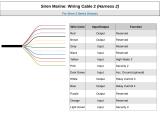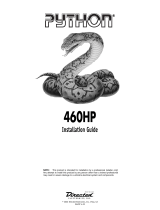
© 2015 Directed. All rights Reserved. 2
QRN3305 2015-08
Programming System Features
The System Features Learn Routine dictates how the unit operates. It is possible to ac-
cess and change most of the feature settings using the Valet switch/Control button.*
*Depending on which model is installed, the system uses either an external Valet
switch and an external Status LED or a Control Center with an onboard Control but-
ton (Valet Switch) and Status LED.
1. Open a door.
2. Turn the ignition on, then off.
3. Select a Menu. Press and hold the Valet switch/Control button. The number
of siren chirps indicates the menu number. 1 chirp indicates menu 1, 2 chirps
- menu 2.
4. When the desired menu chirps are heard, release the Valet switch/Control
button.
5. Select a Feature. Press and release the Valet switch/Control button the
number of times corresponding to the feature you wish to change. Then press
and hold one more time to select the features.
6. Program the Feature. While holding the Valet switch/Control button, you can
program the feature using the remote control.
To change the desired options press;
= one chirp setting, while
= two
chirps setting.
Once a feature is programmed:
• Other features can be programmed within the same menu
• Another menu can be selected
• The learn routine can be exited if programming is complete
To access another feature in the same menu:
1. Press and release the Valet switch/Control button the number of times neces-
sary to advance from the feature you just programmed to the next one you
want to program.
2. Then press the Valet switch/Control button once more and hold it.
To select another menu:
1. Press and hold the Valet switch/Control button.
2. After 3 seconds, the unit advances to the next menu and the siren chirps, indi-
cating which menu has been accessed.
The learn routine exits if any of the following occurs:
• The open door is closed
• The ignition is turned On
• There is no activity for 20 seconds
• The Valet switch/Control button is pressed too many times
Bitwriter - Only Options
If programming with the Bitwriter®, the learn routine can be locked or un-
locked. If the learn routine has previously been locked, it must be unlocked
with Bitwriter® - this cannot be done manually with the Control button.
The Bitwriter® gives you access to a wider range of system options. These
features and the adjustments that may be programmed are described in the table
below. Default settings are in bold type.
Menu
Item
Feature Default Option 2
1 Ignition Controlled
Lock
Ignition Controlled
Lock ON
Ignition Controlled
Lock OFF
2 Ignition Controlled
Unlock
Ignition Controlled
Unlock ON
Ignition Controlled
Unlock OFF
3 Siren Duration
30 second siren
duration
1-180 seconds (in 1
second increments)
Feature Menus
Default factory settings are in bold type.
Menu 1: Basic Features
Feature
#
1- chirp setting 2- chirp setting
1-1
Active arming
Passive arming
1-2
Chirps ON
Chirps OFF
1-3
Ignition controlled door locks
ON
Ignition controlled door locks OFF
1-4
Active locking only
Passive locking
1-5
Panic w/ignition ON
No Panic w/ignition ON
1-6
0.8 second door lock pulses
3.5 second door lock pulses
1-7
Forced passive arming ON
Forced passive arming OFF
1-8 Automatic Engine Disable ON
Automatic Engine Disable OFF
1-9
Armed When Driving (AWD)
Vehicle Recovery System (VRS)
1-10
Code Hopping™ ON
Code Hopping OFF
Menu 2: Advanced Features
Feature
#
1- chirp setting 2- chirp setting
2-1
Siren*
Horn Honk*
2-2
30 second siren duration
60 second siren duration
2-3
NPC®
ON
NPC OFF
2-4
Progressive door trigger
Instant door trigger
2-5
Valet switch/Control button
input: 1 pulse
Valet switch/Control button input
2-5 pulses
2-6
Door trigger error chirp ON Door trigger error chirp
OFF
2-7
Ignition controlled domelight
ON
Ignition controlled domelight OFF
2-8
Single unlock pulse
Double unlock pulse
2-9
Single lock pulse
Double lock pulse
2-10
Channel 3: Validity
Channel 3: latched/
latched reset with ignition/
30- second timed/
second unlock output**
2-11 Comfort Closure (ON, 20 sec)
Comfort Closure (OFF)
* In “Horn Honk” setting the brown wire (12-pin) outputs pulses. In “Siren” setting
the wire outputs continuously. This wire has a (+) polarity output regardless of
setting.
** Second unlock available only if feature 2-8 is programmed to single pulse.
Remote control learn routine
The system comes with two remote controls that have been taught to the control
module. The control module can store up to four different remote control codes in
memory. The button configurations can be changed on the remote control, follow
the procedure below and use the table to configure it for an associated function.
If the system was previously programmed using the 998T Bitwriter, the learn routine
may be locked. If the siren generates one long chirp when attempting to program
the unit, the learn routine is locked and must be unlocked using the 998T Bitwriter
before proceeding.
1. Open a door. The 12 pin harness GREEN wire or the 12 pin harness VIOLET
wire must be connected.
2. Turn the ignition on. The 12 pin harness YELLOW wire must be connected.
3. Select a channel. Press and release the Valet switch/Control button the number
of times necessary to access the channel you want, and then press and hold
the Valet switch/Control button once more. The siren chirps and the LED blinks
the number of times corresponding to the channel accessed.
4. While holding the Valet switch/Control button, press the button on the remote
control you want to assign to the selected channel. The unit chirps indicating
successful programming.
Note: It is not possible to teach a remote control button to the system more
than once.
Note: When programming channels 1- 6, a button must be taught to the unit in
Channel 1 or Channel 5 before programming remaining channels.
Channels 2, 5, 6: Use Channels 2, 5, and 6 to assign the arm, disarm and panic
functions to buttons on the remote control. Teaching a button to Channel 5 or Chan-
nel 1 erases some memory information, and auxiliary functions may have to be
reprogrammed.
Channel/ Function
Channel # Function
1 Arm/Disarm
2 Panic Only
3 Silent mode, Remote Valet,
Trunk Release
4 Remote starter or other accessories
5 Arm Only
6 Disarm Only
7 Auto learn standard 4- button configuration*
8 Auto learn 3- button configuration*
9 Delete all transmitters**
* For auto learn configurations, see Remote control (transmitter) configurations
section of this guide.
** The delete all transmitters option also resets the programmed settings to their
default factory state.
The learn routine exits if any of the following occurs:
• The open door is closed
• The ignition is turned off
• There is no activity for 15 seconds
• The Valet switch/Control button is pressed too many times
Long Term Event History
The system stores the last two full triggers in memory. These are not erasable. Each
time the unit sees a full trigger, the older of the two triggers in memory is replaced by
the new trigger. To access long term event history:
1. With the ignition Off, press and hold the Valet switch/Control button.
2. Turn the ignition On.
3. Release the Valet switch/Control button.
4. Within 5 seconds, press and release the Valet switch/Control button. The
status LED flashes in groups indicating the last two zones that triggered the unit
for 1 minute or until the ignition is turned off. Refer to table of zones.
Note: The Warn Away triggers are not stored to memory and are not reported.
Table of Zones
A zone is represented by the number of status LED flashes used by the
system to identify a particular type of input.
Zone Description Input Description
1 Optional trigger input 12 pin harness Blue wire
2 Instant trigger: a heavier impact
detected by the shock sensor
Onboard Shock Sensor.
3 Door switch trigger 12 pin harness Green or Violet wire
4 Instant trigger: For optional sensors Optional Sensor Port
5 Ignition trigger 12 pin harness Yellow wire



